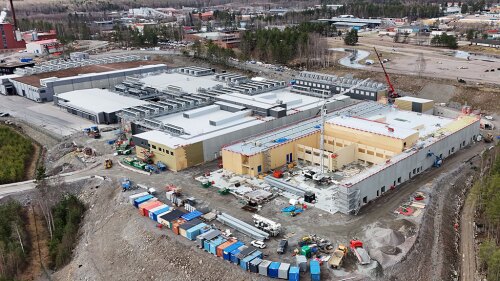The real estate industry has typically addressed carbon emissions with strategies such as greater energy efficiency, low-carbon materials, and tenant engagement and cooperation. Now add an even more critical component to the equation—refrigerant emissions. Any property using HVAC (and nearly all do) should be looking at the building’s refrigerants as the next big compliance and cost risk. Leaks, fines, and refrigerant phase-outs are already impacting asset portfolios. Here’s what real estate professionals need to know.
Refrigerant emissions are superpollutants
The built environment is responsible for a whopping 40 percent of global emissions each year, with heating and cooling activities forming the largest segment at about 15 percent. Compared to other greenhouse gases, however, the volatile chemicals used in today’s HVAC and other self-contained refrigeration systems are much more destructive than carbon dioxide when accidentally released into the atmosphere—up to 2,000 times when measured against the Global Warming Potential (GWP), which benchmarks carbon dioxide at “1.”
We often refer to refrigerants as the ugly duckling of climate solutions, because despite appearing unpromising, properly addressing them can avoid up to 0.5 degrees Celsius of global warming by the end of the century.
Real estate portfolios with high-GWP refrigerants in their assets should begin the process of converting to low-GWP alternatives as soon as possible. Failure to be proactive about the issue could be costly. Refrigerants are an important but often overlooked piece of the emissions problem, with common ones such as R-410A now being forced out.
Regulations are here—noncompliance is costly
As refrigerant emissions comes into sharper focus with growing government oversight, ULI Greenprint has been educating its members through working groups, educational webinars, and in-person sessions on how to mitigate these so-called fugitive emissions. Members voluntarily report their refrigerant emissions annually as part of ULI’s State of Green report.
The issue with today’s refrigerants is hydrofluorocarbons (HFCs), synthetic organic compounds that are the fastest growing greenhouse gases globally. The United Nations Kigali Amendment to the Montreal Protocol stipulates a phase-down of global HFCs by 2047. Individual countries, territories, and states have enacted additional regulations, including large fines for noncompliance. A few examples:
- U.S. AIM Act, Subsection H takes effect January 1, 2026, and calls for tighter rules on HFC leaks, repairs, reclamation standards, record keeping, and reporting. There is some uncertainty over how certain components of the broader AIM Act regulation will be carried out, as there is currently an open public comment period to reconsider rules under the Subsection I (Technology Transition Provisions).
- U.S. EPA Section 608 allows for daily fines up to $37,500 for noncompliance with refrigerant management and reporting. This is relevant for any commercial real estate building with equipment containing more than 50 lbs. (22.68 kilograms (kg) of CFCs and HCFCs (i.e. R22) refrigerant. Compliance requires licensed technicians, leak repair and reporting, data management and collection, and more.
- Washington State Refrigerant Management Program conducts regular leak inspections, makes repairs, and certifies on-site service records for large facilities using more than 50 lbs. of refrigerant with a GWP of 150 or more. Annual fees for 2026 are not yet finalized, but are expected to be capped at $5,000 per facility.
- New York State Part 494 Regulation prohibits sales of bulk refrigerants, including HFCs and other materials, prohibits sale and installation of equipment using HFC refrigerants, and adds labeling, disclosure, and leak requirements.
Planning for the high-GWP refrigerant phase-out
R-410A is the most common refrigerant used for commercial and residential cooling. R-410A replaced past refrigerants that depleted the ozone layer but is now being phased down because of its outsized global warming potential (GWP). The U.S. AIM Act has restricted the production or importation of many appliances using R-410 into the U.S. starting in January 2025. Moreover, beginning in 2029 if a system needs R-410A to be added, only recycled or reclaimed R-410 can be used going forward. It will become increasingly difficult and costly to procure these older, phased down refrigerants over time. Other hydrofluorocarbons (HFCs) are also included in the AIM Act, and will be phased down to 15 percent of their historic baseline levels by 2036.
Real estate can get ahead of these costs by considering low-GWP or “alternative” refrigerants to replace those refrigerants being phased down, like R-410. Some systems will need to be replaced or upgraded to enable the use of new refrigerants, which can be included in future capital expenditure planning. Options for alternative refrigerants depend on the appliance type. When buying new systems, procurement teams should consider maximizing total system benefits, including present and future GWP requirements along with energy efficiency.
Without a plan, leaks and fines will eat into profit margins
Creating a refrigerant management plan is a critical piece of assessing current usage, planning for new regulations, and addressing leaks. When owners can certify that systems are well maintained, and materials handled correctly at every stage, then fugitive emissions can be greatly mitigated and costly fines avoided.
A refrigerant management plan has four key components, which are customized according to need:
- Inventory systems: Develop and maintain an up-to-date list of all assets using refrigerants.
- Track refrigerant events: Use digital sensors and other processes to log leaks, repairs, inspections, and recovery activities.
- Ensure compliant servicing: Work only with licensed service contractors and require proper documentation for all repairs, replacements, etc.
- Strategically retire systems: Phase out leaky or aging equipment in a way that allows for refrigerant recovery and transitions to low-GWP alternatives.
Proactive strategies can reduce operating costs by eliminating leaks, avoiding regulatory fines, and minimizing HVAC downtime. They also strengthen tenant and investor confidence, since refrigerant emissions are increasingly viewed as a marker of operational excellence and climate responsibility. Tighter restrictions on HFCs and other damaging refrigerants are inevitable, so addressing alternatives now can help future-proof real estate assets and avoid costly retrofits.
Read more about similar topics:







